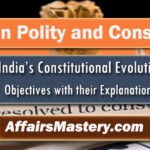Set 3 | Important Indian Constitution Evolution MCQs
Important Indian Constitution Evolution MCQs. The way the Indian Constitution has evolved over time plays a huge role in shaping Indian Polity and Governance, and it’s one of those things that really lays the groundwork for doing well in competitive exams—whether it’s Civil Services, State exams, SSC, Railways, Banking, or any of the others out there. Diving deep into Indian Polity, Constitution, and governance isn’t just about memorizing facts or ticking boxes for exams, but more about developing the kind of awareness that can make navigating these challenging exams a little less overwhelming and a lot more manageable.
| MCQs on Indian Constitution Evolution – Objective Questions and Answers |

Q21. The distribution of power between Centre and States as in the Constitution of India is based on which of the following plans? (I.A.S. (Pre) 2012)
[A] Morely-Minto Reform, 1909
[B] Montagu-Chelmsford Reform, 1919
[C] Government of India Act, 1935
[D] Indian Independence Act, 1947
View Explanation
Correct Answer is C.
- Government of India Act, 1935 was pretty significant because it laid the foundation for how power would be divided between the Centre and the States in India.
- It introduced a structured way of governance by creating three lists:
- Federal List – Matters under the Central government’s control.
- Provincial List – Gave more control to the States.
- Concurrent List – Areas where both the Centre and the States had authority.
- Later, when India adopted its own Constitution, this system didn’t just disappear. It was refined and became part of the Seventh Schedule, keeping the same basic framework but adjusting it to fit the new independent India.
- In a way, this act shaped how India is governed today, making it one of the most important pieces of legislation before independence.
Q22. In the Federation established under the Act of 1935, residuary powers were given to the (U.P.P.C.S. (Mains) 2008)
[A] Federal Legislature
[B] Provincial Legislature
[C] Governor General
[D] Provincial Governor
View Explanation
Correct Answer is C.
Under the Government of India Act, 1935, the division of powers was structured into three lists: Federal List, Provincial List, and Concurrent List. However, any subject that did not fall under these lists was classified as a residuary power.
- Unlike in the Indian Constitution (where residuary powers are with the Centre), under the 1935 Act, these powers were given to the Governor General.
- The Governor General had the authority to decide on matters not mentioned in the three lists and could make laws on them as needed.
- This reflected the continued dominance of British rule, as the Governor General was ultimately responsible to the British Crown.
Thus, the Governor General held the residuary powers in the federation created by the Government of India Act, 1935.
Q23. Which one of the following is not an important and permanent constituent in the Constitutional History of India as adopted in the Government of India Act, 1935? (U.P.P.C.S. (Mains) 2010)
[A] A written Constitution for the country
[B] Elected representatives responsible to the Legislature
[C] Envisaging a scheme of Federation
[D] Nomination of official members to the Legislature
View Explanation
Correct Answer is A.
- The Government of India Act, 1935 didn’t really talk about having a written Constitution for the country. That idea wasn’t part of it. But later on, in 1940, the British Government kind of started agreeing with the demand for an independent constitution, and this came through what is called the ‘August Offer’. Through this, they basically accepted that Indians should have the main responsibility for framing their own constitution.
- Then, in 1942, things moved a little further when Sir Stafford Cripps, who was a member of the British Cabinet, arrived in India with a draft proposal. This proposal was meant to lay out how an independent constitution would be framed, but not immediately—it was something they planned to take up after World War II.
- It was one of those moments where the British tried to offer something, but at the same time, they still wanted to hold on to control.
Q24. One amongst the following was not a salient feature of the Government of India Act, 1935: (R.A.S./R.T.S. (Pre) 2016)
[A] The Act provided for an All India Federation
[B] Residuary subjects were allocated to provincial Legislatures.
[C] It marked the beginning of the Provincial Autonomy.
[D] It abolished Diarchy at the Provincial level and introduced it at the Centre.
View Explanation
Correct Answer is B.
The Government of India Act, 1935 had several important features, but residuary subjects were NOT given to the provincial legislatures. Instead, they were placed under the control of the Governor General, who had the authority to decide on such matters.
Other correct options:
- [A] The Act provided for an All India Federation → It proposed a federation including both British India and princely states (though it was never fully implemented).
- [C] It marked the beginning of Provincial Autonomy → The Act gave provinces more powers and ended direct interference from the British government in provincial matters.
- [D] It abolished Diarchy at the Provincial level and introduced it at the Centre → The confusing dual system (Diarchy) in provinces was removed, but it was introduced at the Centre, meaning certain areas were controlled by elected ministers, while others remained under the Governor General’s direct authority.
Q25. Why is the Government of India Act, 1935 important? (U.P. Lower Sub. (Pre) 2015)
[A] It is the main source of the Constitution of India
[B] It gave Independence to India
[C] It envisages partition of India
[D] It abolished the Native States
View Explanation
Correct Answer is A.
The Government of India Act, 1935 is considered highly significant because many of its provisions were later adopted and modified in the Indian Constitution of 1950. Some key aspects include:
- Federal Structure → It introduced a three-list system (Federal, Provincial, and Concurrent lists), which influenced India’s current Union, State, and Concurrent Lists.
- Provincial Autonomy → It allowed provinces to function more independently, a concept later carried into the Indian Constitution.
- Diarchy at the Centre → Though India later removed Diarchy entirely, this Act introduced it at the central level, laying the foundation for governance models.
- Judiciary and Public Service Commissions → It established institutions like the Federal Court, which later evolved into the Supreme Court of India.
Q26. Which one of the following Acts led to the separation of Burma from India? (U.P.P.C.S (Mains) 2011)
[A] The Indian Councils Act, 1909
[B] Government of India Act, 1919
[C] Government of India Act, 1935
[D] Indian Independence Act, 1947
View Explanation
Correct Answer is C.
- The Government of India Act, 1935 was responsible for the separation of Burma (now Myanmar) from British India, which came into effect on 1st April 1937.
- The British wanted to govern Burma separately due to administrative differences and increasing demands for self-rule from Burmese leaders.
- This Act created Burma as a separate colony, meaning it was no longer governed as part of India but directly under the British Crown.
- [A] The Indian Councils Act, 1909 → This was the Morley-Minto Reforms, which introduced separate electorates but had nothing to do with Burma.
- [B] Government of India Act, 1919 → This was the Montagu-Chelmsford Reforms, which introduced Diarchy in provinces but did not separate Burma.
- [D] Indian Independence Act, 1947 → This Act granted independence to India and Pakistan, but Burma was already separated in 1937.
Q27. The proposal for framing of the Constitution of India by an elected Constituent Assembly was made by (U.P.P.C.S. (Spl) (Mains) 2008)
[A] Simon Commission
[B] Government of India Act, 1935
[C] Cripps Mission
[D] British Cabinet Delegation
View Explanation
Correct Answer is D.
- The idea of framing India’s Constitution through an elected Constituent Assembly was formally proposed by the British Cabinet Mission in 1946.
- The Cabinet Mission Plan suggested setting up a Constituent Assembly that would be responsible for drafting the Constitution of free India.
- Based on this proposal, elections were held, and the first meeting of the Constituent Assembly took place on 9th December 1946.
- [A] Simon Commission (1927) → It reviewed the working of the Government of India Act, 1919, but it did not propose an elected Constituent Assembly.
- [B] Government of India Act, 1935 → This Act provided for provincial autonomy and federal structure, but it did not talk about framing an Indian Constitution by elected representatives.
- [C] Cripps Mission (1942) → This mission, led by Sir Stafford Cripps, proposed Dominion status and the right for Indians to draft their own Constitution after World War II, but it was not a concrete plan for a Constituent Assembly.
Q28. The objective of Ilbert Bill in reference to colonial rule in India was- (I.A.S. (Pre) 2003)
[A] To bring Indians and Europeans at equal status as far as the penal jurisdiction of courts was concerned.
[B] To put a strict restriction on local press because they were considered anti to colonial rulers.
[C] To conduct Administrative Service Exams in India to encourage Indians to participate in it.
[D] To amend the Arms Act for weapon permit to Indians.
View Explanation
Correct Answer is A.
- The Ilbert Bill was introduced in 1883 by Lord Ripon’s Law Member, Sir Courtenay Ilbert.
- The main objective of this bill was to allow Indian judges and magistrates to try European British subjects in criminal cases, which was previously not allowed.
- Before this, Indian judges were not permitted to handle cases involving Europeans, creating a clear racial discrimination in the judicial system.
- However, the bill faced strong opposition from the European community in India, leading to modifications that weakened its original intent.
Q29. As per Cabinet Mission plan, in the Constituent Assembly to decide allotted members seat in each province, one representative was in ratio to which population? (U.P. P.C.S (Pre) 2003)
[A] 8 Lakh
[B] 10 Lakh
[C] 12 Lakh
[D] 15 Lakh
View Explanation
Correct Answer is B.
- According to the Cabinet Mission Plan of 1946, the Constituent Assembly was formed to frame the Constitution of India.
- The seats allotted to each province in the Constituent Assembly were based on its population size, with one representative for every 10 lakh (1 million) people.
- The total strength of the Constituent Assembly was 389 members—296 seats for British Indian provinces and 93 seats for princely states.
- Out of the 296 seats for British Indian provinces, members were indirectly elected by the Provincial Legislative Assemblies.
Q30. Who among the following persons was not a member of the Cabinet Mission? (U.P. Lower Sub. (Pre) 2015)
[A] William Wood
[B] Pethick-Lawrence
[C] Stafford Cripps
[D] A.B. Alexander
View Explanation
Correct Answer is A.
The Cabinet Mission (1946) was sent by the British government to discuss the transfer of power to Indian leaders and propose a framework for India’s Constitution.
Members of the Cabinet Mission:
- Lord Pethick-Lawrence → Secretary of State for India (Leader of the Mission)
- Sir Stafford Cripps → President of the Board of Trade
- A.V. Alexander → First Lord of the Admiralty
Related articles:
- Set 1 | Important Indian Constitution Evolution
- Set 2 | Important Indian Constitution Evolution
- Set 4 | Important Indian Constitution Evolution
- Set 5 | Important Indian Constitution Evolution
- Set 6 | Important Indian Constitution Evolution
- Set 7 | Important Indian Constitution Evolution
- Set 8 | Important Indian Constitution Evolution




